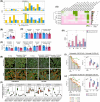Systematic profiling of cancer-fibroblast interactions reveals drug combinations in ovarian cancer
- PMID: 40411295
- PMCID: PMC12420376
- DOI: 10.1002/1878-0261.70051
Systematic profiling of cancer-fibroblast interactions reveals drug combinations in ovarian cancer
Abstract
Ovarian cancer (OC) is a leading cause of death of gynecological cancers in women. Poor patient response to treatment highlights the need to better understand how the tumor microenvironment affects OC progression. Growing evidence indicates the crucial role of non-cancerous components, such as cancer-associated fibroblasts, in establishing a complex network of cellular and molecular interactions, influencing cancer progression and response to treatment. Therefore, in this study, we sought to characterize the impact of fibroblasts on OC cell behavior and drug response. Using both direct and indirect cell co-culture systems, we observed distinct changes in cancer cell proliferation, morphology, and secretome in the presence of fibroblasts. Furthermore, an imaging-based high-throughput drug screen of 528 oncology compounds revealed multiple drugs that showed altered efficacy in the co-culture conditions, demonstrating the role of fibroblasts in driving cancer cell resistance to treatment. Most importantly, our data identified the two drug combinations of Birinapant or Vorinostat with Carboplatin as promising treatments, exploiting the altered cancer cell phenotype in co-cultures. These findings were supported by the increased sensitivity of ex vivo cultures to these combinations.
Keywords: cancer‐associated fibroblast; drug screen; ovarian cancer; tumor microenvironment.
© 2025 The Author(s). Molecular Oncology published by John Wiley & Sons Ltd on behalf of Federation of European Biochemical Societies.
Conflict of interest statement
OK is a board member and co‐founder for Sartar, advisor to the Knut and Alice Wallenberg Foundation, Novo Nordisk Foundation, and Sitra.
Figures




References
-
- Colombo N, Sessa C, du Bois A, Ledermann J, McCluggage WG, McNeish I. ESMO–ESGO consensus conference recommendations on ovarian cancer: pathology and molecular biology, early and advanced stages, borderline tumours and recurrent disease. Ann Oncol. 2019;30(5):672–705. 10.1093/annonc/mdz062 - DOI - PubMed
MeSH terms
Substances
Grants and funding
LinkOut - more resources
Full Text Sources
Medical

